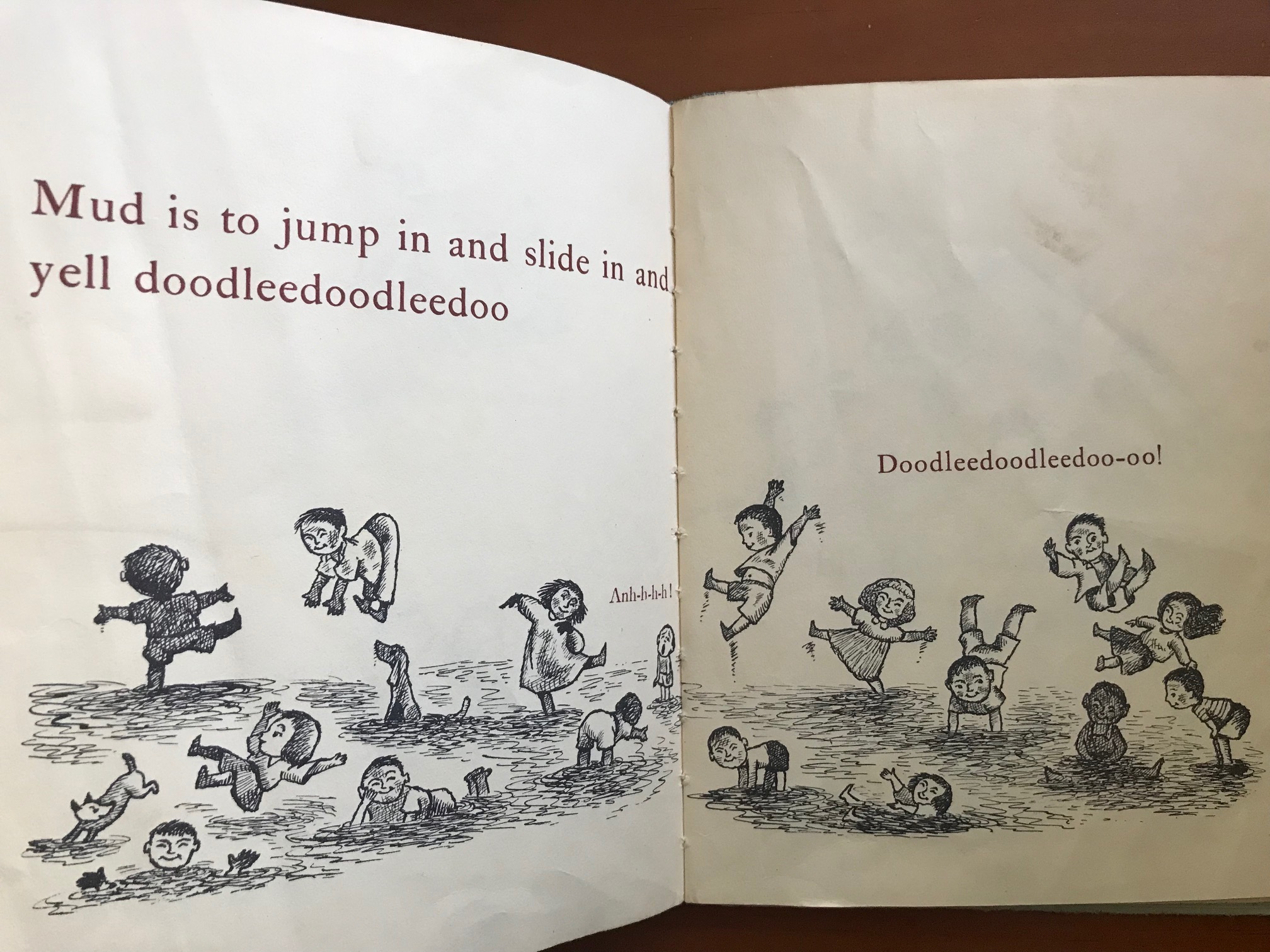
My parents valued reading. One of my earliest memories is walking up the sidewalk, climbing a few steps, and emerging onto the Washington University campus where my father’s office hid in an old brick building. He was teaching and finishing his thesis in economics, and this was a rare glimpse of his world. I must have been four, my sisters six and two; I don’t recall if we made our way alone, or if my mother brought us and then left so she could have a moment of respite. I just remember it was the girls crowding around my dad, and it was a very special time. Each week, he put aside his work and read us a chapter from Robin Hood—Maid Marian, Friar Tuck, the Merry Men, the Sheriff of Nottingham, Little John falling into the water—before we returned to the cramped domesticity of our grad student pre-fab housing.
I just remember it was the girls crowding around my dad, and it was a very special time. Each week, he put aside his work and read us a chapter.
Not surprisingly, I loved to read too. When I was in second grade, I would sneak-read stories from my older sister’s third grade book on Greek mythology. The Saigon American school must have contracted with the Calvert distant learning curriculum, and I can still picture the dark silhouette of a head gracing orange covers, with long spelling lists or math lessons inside. But the mythology book was a blue soft-cover, spiral bound, 8 ½ by 11-paged delight, with coloring book style illustrations and enchanting stories–the race with the golden apples, the abduction of Persephone to the underworld, the legend of Icarus. Lucky me, I got my own third-grade book the following year, and learned everything by heart. And then, when we returned home to Michigan, we stopped in Italy, where I found “my” stories in the museums, magically embodied in marble-fleshed statues.
We had children’s books at home, and I still haven’t been able to part with some of them a lifetime later, their bindings cracked, the odd crayon scribble inside. We even had my father’s old “Elson Readers”, with its quaint pictures inside and an introduction that declared, “Kindness, helpfulness, contentment, industry, promptness, gratitude, love of Mother, and obedience are attractively portrayed in interesting stories, yet without any of the atmosphere of preachiness.” While not entirely bad, you could probably come up with some alternative ideas to promote in a nanosecond.
I can still picture the illustrations from Robert McClosky’s “Blueberries for Sal” (Sal and Little Bear get mixed up on blueberry hill gathering food for the winter, and follow the wrong mother), and “Make Way for the Ducklings” (set in Boston Commons).
The irritatingly repetitive message from “The Little Engine that Could”’s message (I think I can, I think I can), was imprinted in my brain for life. More fun was “A Hole is to Dig”, with pictures by Maurice Sendak; my favorite page was “Mud is to jump in and slide in and yell doodleedoodleedoo!” I loved the colorfully rich European costumes in “My Mother is the Most Beautiful Woman in the World” (set in Hungary, a lost child describes her mother–who in her eyes is the most beautiful), and the same illustrator, Ruth Gannett, created the world of Tangerina and Wild Island in “My Father’s Dragon”. “Charlotte’s Web” (the spider and the pig) was sad but beautiful.
A.A. Milne’s “Winnie the Pooh” and “Now we are Six” were favorites of my parents, told with a subtle wit that spoke to adults (and spawned “the Tao of Pooh” later on). Robert Louis Stevenson’s “A Child’s Garden of Verse” provided many hours of re-reading, as did “The Arbuthnot Anthology”, a thick hardcover compendium with over 400 thin pages full of poems, short stories, and excerpts from longer works. The table of contents alone was 12 pages. You could open it at random and always find something new.
My mother also brought home the The Golden Book Encyclopedia along with groceries from the A & P, gradually accumulating the set; it was pretty basic but provided endless choices of disparate bits of information about the world. I’m not sure how we ended up with “A Child’s History of the World” (Spartans—hard as nails! The little dog who greeted the returning Odysseus and then died of joy!). I was enthralled but my history-teacher mother rolled her eyes at it, and I think it was probably the worst sort of Eurocentric simplistic junk foisted off on kids.
Not all stories came in books. We had some 78 rpm records—Robin Hood, Sleeping Beauty, cowboy songs, nursery rhymes—with narration and songs that survive as earworms yet. And I buried myself in the guilty pleasure of stacks of Classic Comics (Mutiny on the Bounty, A Connecticut Yankee in King Arthur’s Court, The Prince and the Pauper) that were kept to divert kids who were waiting outside the room where the next extracurricular dance class would soon start (my mother had signed me up); I confess that I devoured the comics while hiding in the corner instead of joining the class.
Instead of Disney princesses, I recall “A Little Princess” by Francis Hodgson Burnett (classic orphan story with lush illustrations), and “The Green Fairy Book” (traditional stories–also came in other colors, but mine was green).
Although I suffered the inanity of “Dick, Jane and Sally” (Look, look, oh look! See Spot run!), the small library room tucked into the basement of Marble Elementary School was stocked with rafts of book series for children—“The Hardy Boys”, “Nancy Drew”, orange-bound biographies of famous Americans from their childhood, which I binged on like a latter-day Netflix series. That’s where I also found dog books—“Big Red”, “Irish Red” by Jim Kjelgaard, and “Banner in the Sky” by James Ramsey Ullman (mountain climbing thrills).
Of course not all children have the same experiences with reading, and the tsunami of telecommunications has imperiled books. Back in 1989, a group of pediatricians from Boston City Hospital were concerned about children growing up in homes without books or reading, so they developed a program called “Reach Out and Read”. I found out about it when they contacted my Community Health Center to join the effort (there are now thousands of participating sites). What a great idea–link health and education, and make reading part of every well-child medical visit.
The plan is simple. In addition to getting height and weight, and other preventive health measures, the provider gives a book to the child, talks with the caregiver about how reading fits into the child’s level of development, and explains how to use the book. They take the book home. It is never too early to start–even an infant can enjoy thick books with bright colors and textures. The available books include families of different cultures, colors, and languages, and fortunately there are more diverse choices than when I was a kid. Over time, the home will have a small library.
If a caregiver doesn’t have good literacy skills, they can still tell stories about the pictures and use the book to reinforce their bond with the child. Where volunteers are available, they spend time in the waiting area, showing through their actions how to share books and stories with the children. COVID has doubtlessly limited the program, but there is hope for the future.
To paraphrase Clement Moore: “Happy reading to all, and to all a good night.”


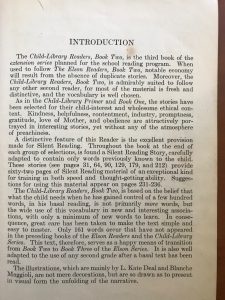
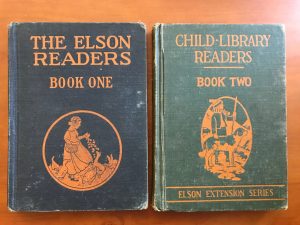
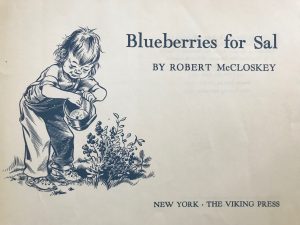
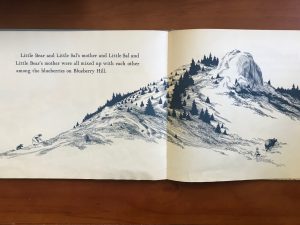
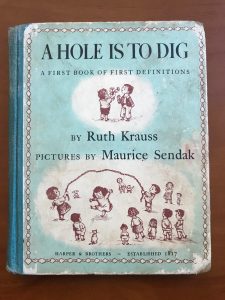
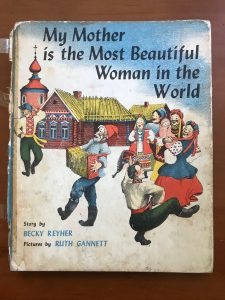
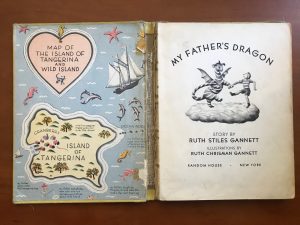
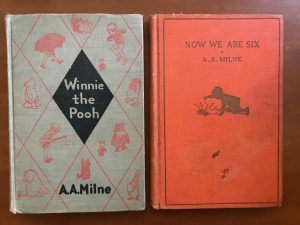
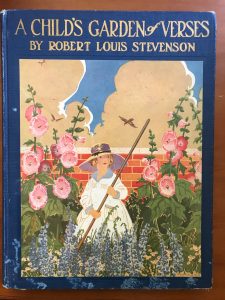
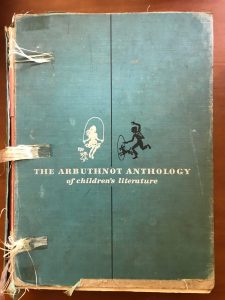
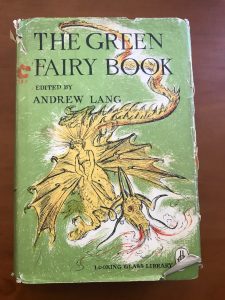

Thanx Khati for your own history of books and reading, and telling us about the wonderful Reach Out and Read” initiative.
The more such programs that promote reading the better, there is one called Barbershop Books that places collections of books for the taking in barbershops in African American neighbors in participating cities.
And I always admired Oprah’s Book Club started years ago.
And a shout-out to a non-profit I support called Literacy for Incarcerated Teens that builds libraries and book collections in juvenile detention centers in New York.
http://www.LiteracyForIncarceratedTeens.org
It inspiring to hear about the wonderful programs that support literacy. Thanks for sharing those examples—they cheered me up. We need them.
This is such a comprehensive “library” of books, Khati, some of which I know, and others that are new to me. Love the photos of the old books. I wish I still had my multi-volume set of fairy tales, beautifully illustrated in color, but alas, they didn’t survive my parents’ cross-country moves.
I was a little reluctant to dive into the list, but couldn’t help myself once I got started. I hoped it would resonate with other people’s recollections, and from some of the other postings, it seems I am not the only one with fond memories of many books. Books were one of the ways we got outside our daily lives and started connecting to a bigger world.
What a wonderful anthology of books, Khati. And I even vaguely remember hearing about the Elsen Readers.
Hard to single out any real favorite here, though I must admit that, of the McCloskey books, my favorites were “Homer Price” and “Centerburg Tales” (also featuring Homer and his family). I wonder if they were more “boy stories.”
And bravo/a for “Reach Out and Read.” Of course, it is preaching to the converted among us Retro folks, but you have well described the joys and benefits (including helath) of lifelong reading.
Well I don’t think I ever saw those other McClosky stories, and maybe my parents picked out the “girl” ones, but one of the nice things about many children’s books is that they aren’t always clearly gendered. In fact, the maligned Suess books seemed pretty generic. “A Hole is to Dig” was also just very full of the joy of being a kid. I think you are right that this Retrospect group is full of bibliophiles.
Reach Out and Read is a wonderful program. With the (almost) death of the brick and mortar bookstores and the pandemic limiting access to libraries, I fear many children are not growing up with books as we did. You mentioned so many wonderful ones in your story and I’m jealous that you still have your childhood books. I had a set of my father’s (Tom Swift and his Electric Rifle) that didn’t interest my kids. When we moved, no one wanted them so I donated the series. Now I deeply regret that, but I still have my mother’s copy of Little Women, although it is too fragile to read.
I thought you might be familiar with the program, and I do think it is genius. I still find that, not just children’s books, but books in general, are getting harder to hold onto and to dispose of-I have long ago run out of room, and no one seems to want the precious volumes I have clung to. Sigh.
I, too, loved mythology, Khati. I wasn’t familiar with many of the books you mentioned, but that made your story even more interesting for me. And I love the Reach Out and Read program. It makes so much sense in this age of everyone being online and playing video games all the time.
My husband sent me an op-ed piece from the Washington Post by Eugene Robinson last night about just how dumb are Americans? They no longer value education or the educated; they elected a calculating “star” from the celebrity TV culture; a known liar, cheater and philanderer, because he “tells it like it is”, “they saw him TV”, etc. This is what is now valued. Truly scary stuff.
Scary indeed. Education is the bedrock of democracy, and books play such an important role. Can’t give up.
Khati, you have reminded me of so many beloved books that I had forgotten about. I do believe I still have a copy of A Hole is to Dig somewhere in this house, but it is so small that it is easy to lose in a bookcase. A Child’s Garden of Verses is much taller, and also probably in one of my bookcases. And Classic Comics! I now remember those vividly, thanks to you, and what a great way to get early exposure to some wonderful novels that we might read in full later on. Of course I could not forget the A.A. Milne books, his poems just as delightful as his Pooh stories. Thanks for your memories and your pictures.
It does sound like we enjoyed a lot of books in common. When I dug out the ones I still have and leafed through them, they were still good stories (mostly). I have to admit that I never read the books that the comics derived from—still a long reading bucket list for me.
Speaking of those earworms: Did you have on 78 rpm the story with the jingle, “I’m Squeaky the Telephone, I’m down the hall, children all use me to make a call…Turn the dial with a click-click-click…”
This was a fun trip down your memory lane, some of which overlapped with mine.
Squeaky the telephone didn’t show up, but we had “Hey, Betty Martin, tippy-toe”, and “Go tell Aunt Rodie—the old grey goose is dead”—they seemed to call on old nursery rhymes I never heard anywhere else. The cowboy record was the best (“Old Chisholm Trail”, “Cool Water”, Streets of Laredo”, “Colorado Trail”). The telephone ear worm for me is still the radio advertisement, “IV2-1444 brings a Michigan Yellow Cab right to your door”. Maybe Squeaky is preferable.
Such a rich lode, Khati. Seuss and Milne and Sendak and Stevenson were masters. Many of my favorite children’s books (and cartoons) are those with, as you mentioned, sly and/or subtle wit. I understand simplifying the language for children, but I think it’s too bad so many modern books are “dumbed down” with overly-simplified language and laden with heavy-handed messages. The true classics are those subtly coax young minds to bend and stretch and open.
I have a book in front of me entitled “Katooticut” with the subtitle, “The Story of A Rooster.” Published in 1899, I can’t find much about it online and there don’t seem to be any copies available. But it is so witty and charming, as are the illustrations by J. M. Condé, an early 20th century “golden age” book illustrator and comic strip artist best known for his energetic line work. The preface says, “This is a good book. I know it is, because I wrote it myself.” It goes on: “Chapter 1 – Explains some things the Reader really ought to know and gets the story nicely under way. To her Royal Sweetness, The Princess Browneyes.” I might just have to read it again.
Katooticut sounds delightful—how do you have it in front of you? The description sounds a bit Mark-Twainish. There is so much that was written long ago that is still wonderful, but lost now. In fact, remembering the stories I knew and loved, I wonder how many are already archaic. I guess that is the beauty of Retrospect—others recall similar things instead of giving an “okay boomer”. But they were good!